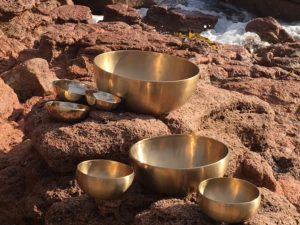Even though the singing bowls are used these days to signal beginning and end of the silent meditation in buddhist practices, the origins of singing bowls are most likely to be in the pre-buddhist Bon culture era. Presently the bronze metal bowls are used in the East in variety of ways from food containers to a musical instrument in buddhist monasteries. In the West, as instrument of meditation and relaxation in various sound therapies.
The original function of singing bowls from Tibet to Northern India is not completely known. Were they sound instruments or sacrificial bowls or did they serve as eating utensils? (1)
“The real origins of the bowls and intentions of the makers are unfortunately lost in time. While there is some folklore about the makers of the singing bowls, typically knowledge of a singing bowl’s origin died with its first or second owner.() Some bowls bear inscriptions indicating they were gifts to monasteries.() There were a number of references in literature to brass bowls being a common dowry item or wedding gift which would attest to their practical utility and very few references to bowls in regard to their musical quality.()
Bowl making was literally a cottage industry with crude smelting and careful metalworking taking place in the home of the artisan. Singing bowls were often made to order; for some of the most special bowls a highly skilled artisan might be provided with very unique materials.”(2)
Bowls were typically made of high-quality bronze, with combinations of various other metals, including gold, silver and even highly prized meteoric iron, which the Tibetans call “sky-metal” or thogcha. The popular culture maintains that the ancient singing bowls should contain seven (for each planet) to twelve metals.
The singing bowls of varied shape and size are in fact a type of standing bell. Rather than hanging upside down or attached to a handle, singing bowls sit with the bottom surface resting, and the rim vibrates to produce sound.
The singing bowls come in all shapes, sizes and tonal gradation. Their weights vary according to the metal alloy and size, thickness of the walls and rim.
Sound of the Singing Bowls
 One feature common to all good quality singing bowls is their characteristic long-lasting, rich in overtones sound. The sound depends on form, material, and strength of the rim. One plays the bowl by striking it gently with a padded felt mallet or rubbing the rim with a wooden stick. See our YouTube channel for instructions.
One feature common to all good quality singing bowls is their characteristic long-lasting, rich in overtones sound. The sound depends on form, material, and strength of the rim. One plays the bowl by striking it gently with a padded felt mallet or rubbing the rim with a wooden stick. See our YouTube channel for instructions.
“Sound healing practitioners find that by applying specific sound frequencies to the effected region, normal function returns in most cases. The cells of the organ or system are effectively re-harmonised and re-energised so that cellular re-programming takes place. Modern audible sound therapy instruments are non-invasive and are essentially like playing music to the body. However, the frequencies they employ are carefully targeted, unlike the broad range of frequencies heard in music and traditional sound healing instruments.”
The idea that the sound could benefit our body and assist in our healing comes from ancient knowledge passed on in Vedas, shamanic traditions as well as scientific research into effects of sound on human body and psyche. “A great deal of this research has centred on the use of music as a means of reducing feelings of anxiety and stress as well as aiding in the relief of numerous pathologies. The precise mechanism responsible for these mediated effects has never been truly determined.”
However a theory exists by Halina and Marek Portlaski, which explains how the non harmonic multi-tones of the good quality singing bowls create binaural beats effect, thus encouraging alpha or even theta brain waves bringing fast and total relaxation.
To find out more about the sound, overtones and sound quality of the singing bowls, join our Body – Sound Basic workshop
References:
-
Singing bowls for Health and Inner Harmony; Peter Hess
-
bestsingingbowls.com
-
John Stuart Reid and Annaliese Kohinoor; Rediscovering the art and science of Sound healing
-
Sound Therapy Induced Relaxation: Down Regulating Stress Processes and Pathologies; Elliott Salamon, and Minsun Kim, John Beaulieu, and George B. Stefano
-
M. Portalski PhD, H Portalski PhD; Poznan University of Technology

